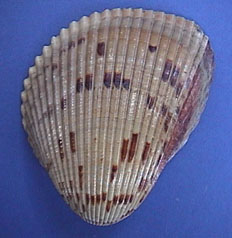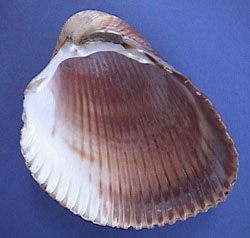|
Atlantic Giant Cockle (Dinocardium robustum)
|
|
The Atlantic Giant Cockle, also known as the Great Heart Cockle, is the most common cockle, out of the seven found in the Carolinas. This large and sturdy shell can grow up to 5 inches in length and is creamy white to tan in color, although some have dark, reddish-brown spots. Radial ribs run from the hinge to the outer edge of the shell on both the inside and the outside, leaving the edges scalloped. Each half of the shell is identical in shape and size and is therefore called equivalves. A strong muscular foot allows them to burrow into sediment where they extend siphons above into the water to filter for plankton and detritus. Cockles are found living in shallow water to water that is 100 feet deep. This species is 65 million years old. Other species such as the Yellow Cockle and Atlantic Strawberry Cockle are found in large numbers on some beaches in the Carolinas. Cockles are eaten in European countries and also used in chowder in the United States. |

